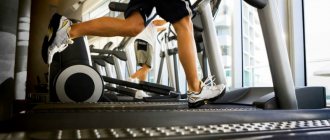Many people know that cardio is the best way to quickly lose 5-7 extra pounds. To lose weight, you need to spend calories, and it is during running or other aerobic exercise that they are burned most actively. But it’s important not to forget about working out in the gym, because strength training triggers calorie consumption even at rest. If you want to get rid of extra pounds, then cardio and strength training for weight loss is a great combo. Come to the Multisport fitness club to get an individual nutrition and training program that works one hundred percent.
Should you do cardio after strength training?
Cardio typically lasts between 20 and 60 minutes and is performed either before or after your main strength training session.
A 10-minute run on a treadmill is not cardio, but only a warm-up or cool-down, the purpose of which is to warm up and prepare the muscles, ligaments and joints, as well as the cardiovascular and nervous systems for the main work or their recovery after it.
Cardio training can be done both indoors (on a treadmill or other cardio equipment) and outdoors (jogging in the park, cycling, etc.).
What equipment should I use for cardio training?
It is believed that the most effective machines for cardio are a treadmill, a rowing machine, an elliptical (orbitrack) and exercise bikes.
Photo: istockphoto.com
With the right technique, running is an excellent form of cardio for fat loss. All you have to do is monitor your heart rate by speeding up or slowing down. Of course, jogging in the fresh air will be most beneficial. But for those who don’t like to get extra cold, a treadmill is also suitable.
Run, Forest... or don't run: Can I lose weight if I hate running?
How and when to combine strength training and cardio
Cardio is performed before or after strength training. But it's important to understand that incorporating cardio into your workout routine depends on what style of training you're doing. So, for example, you don't necessarily need to do 60 minutes of cardio if you do CrossFit, because this type of strength training itself involves a very high intensity workout. In this case, 20-30 minutes of work on a cardio machine before or after training will be quite enough.
Classic options for combining cardio and strength training:
- Cardio before or after strength training;
- Cardio on the day of strength training, but separately from it, with an interval of several hours (for example, in the morning - cardio, in the evening - strength training);
- Do cardio on a separate day (for example, alternating a cardio day with a strength training day).
Cardio programs at FitCurves fitness clubs
Fitness experts from the international network of FitCurves clubs have developed a set of training programs that combine elements of cardio training and classic strength training. The program was created taking into account the female anatomy and characteristics of the female body and is aimed at healthy weight loss, development of flexibility, endurance and the creation of a slender, toned body.
30-minute workouts using the Fitkervs system include a warm-up, a set of strength exercises on unique hydraulic exercise machines, interspersed with rest at special recovery stations, as well as intense cardio, which allows you to burn calories more effectively and get rid of excess weight. The right combination of cardio training with exercise equipment helps to get the maximum fat-burning effect even from a short half-hour session.
FitCurves fitness rooms also offer other types of cardio training, for example, the modern dance style “Live by Dancing.” Active dancing to fiery tunes is more reminiscent of a fun party than a classic sports training, so they not only help burn calories, but also perfectly lift your spirits, energizing you for the whole day.
Cardio before strength training
- Cardio before strength training is not recommended for those whose goal is to lift more weight. This is due to the fact that cardio training requires a lot of energy, which later you may not have enough when working with iron. To confirm this, studies were conducted in which it was proven that of two groups of people with the same physical fitness and strength indicators, those who did not do cardio before were able to gain more weight.
- It is recommended to do cardio before strength training for those who are currently training with light to medium weights in a high-repetition style. Read more about training for relief while cutting →
In general, pre-workout cardio in many cases is used not so much to burn subcutaneous fat, but to warm up and prepare muscles for the load.
Basic recovery methods
During the period when the athlete is resting from exercise, training must be stopped. An important means for muscle growth and maintaining the body in good shape is sleep. It is at this time that muscle tissue actively grows and increases in volume. You need to allocate at least 8 hours for sleep. A few more conditions must be observed - for good rest, it is better to fall asleep in complete darkness and silence, on a comfortable pillow and a comfortable mattress.
The following means affect the improvement of sports performance and recreation efficiency:
- Gradual slowdown. It is not advisable to complete a session in the gym with strength exercises. In this case, stretching or a cardio stationary bike or treadmill at an easy pace will help.
- Drink plenty of fluids. Water remains the best way to support the body, as it affects a large number of processes. Water prevents overtraining and promotes effective rest. However, you should not drink in large quantities. Instead of drinking a bottle at once, it is better to take several sips. Large amounts of water strain the heart.
- Compliance with diet. It is recommended to eat nutritious food, since it is during the first 30 minutes that the body absorbs carbohydrates and amino acids. Depending on the intensity, duration of exercise and physical fitness, each athlete selects the right amount of food.
- Use of special additives. Modern pharmacology offers medications for quick recovery. These can be plastic tablets that accelerate protein synthesis, adaptogens and energy drinks that accelerate the absorption of nutrients. Despite the benefits of the drugs, they should be used only after consultation with your doctor.
- Temperature effect. High temperature improves blood circulation and increases the speed of metabolic processes - cells regenerate faster, muscle tissue is better restored. A positive effect, in addition to a warm sauna, is observed when the temperature decreases. Swimming in an ice bath and rubbing with ice improves the condition because it relieves muscle swelling.
- Massage. The procedure, which is recommended to be performed in the first 30 minutes after training, relieves pain in muscle tissue. It is suitable for every athlete and can be combined with other recreational aids. Massage reduces muscle swelling, reduces fatigue, improves blood circulation and relieves muscle spasms.
- Recovery workout. Aerobic exercise and gentle cardio are suitable. A light jog or bike ride for 10-15 minutes at a calm pace will speed up blood circulation and disperse lactic acid.
After physical exercise, foods with carbohydrates and proteins are recommended. To grow muscle mass, it is enough to consume 50-90 grams of complex carbohydrates and 20-30 grams of animal protein. Additionally, you can use protein shakes.
Cardio exercises after the main lesson should be given more attention, because they strengthen the heart. The duration of cardio training depends on how you feel. If after physical exercise your heart rate exceeds your norm by more than 20-30 beats, light cardio is necessary. It will remove metabolic waste products from the body. It is recommended to do 2 minutes of low-intensity exercise for every 10 beats above normal heart rate. If the heart rate is about 140 beats, and the norm does not exceed 60, then the required duration of cardio is 16 minutes. Organizing a high-quality restoration process requires knowledge and experience. To choose the right distribution of forces, we recommend turning to professional trainers. Qualified fitness instructors will offer you an individual program. You can buy a gym membership online or in our club. By phone you can get additional advice about discounts, promotions and benefits of the club card.
Cardio after strength training
Cardio after strength training is a recognized standard in building a beautiful, sculpted body with a low content of subcutaneous fat. The benefit of doing cardio after the main workout is that during strength work the body spends a large amount of energy obtained from consumed carbohydrates, so when it’s time for cardio, it has to draw energy from reserves, that is, from subcutaneous fat . This approach is followed by many famous athletes both in Russia and abroad.
What is the problem?
So there is a heart rate at which the highest percentage of calories burned is from fat. This gave rise to the idea of the need to exercise only in the “fat burning zone”.
But just because more fat is used as a percentage, does not mean that a lot of fat is wasted in absolute terms.
Example
- You walk slowly at a speed of 3 km/h and burn 5 kcal/min. You burned 300 calories, almost all of them from fat.
- You run at a speed of 9 km/h and burn 15 kcal/min. You burned 900 calories, but only half of it was fat. In percentage terms, you burned less fat, but in absolute terms - 450 calories, and that's more. Obviously, we burn more calories when we exercise intensely.
Lyle MacDonald writes:
High-intensity cardio may be more effective for weight loss. Under these conditions, you deplete your glycogen stores since carbohydrates are your primary source of fuel. But after training at rest, the body will burn more fat, and the carbohydrates supplied with food will go into glycogen. But in the grand scheme of things, everything you burn during a workout is less important than what you burn throughout the day (i.e., you're in a calorie deficit).
How to alternate cardio and strength training for weight loss
To lose weight and burn subcutaneous fat, you need to do more cardio than usual, this is obvious. But is it worth increasing the duration of cardio for this? No. It will be better if you do cardio training on separate days, but do not exclude it from your strength days. So your weekly training plan might look something like this:
- Day 1: Legs, shoulders, cardio (20-30 minutes).
- Day 2: Rest.
- Day 3: Chest, triceps, cardio (20-40 minutes).
- Day 4: Cardio (50-60 minutes).
- Day 5: Back, biceps, cardio (20-30 minutes).
- Day 6: Cardio (50-60 minutes).
- Day 7: Rest.
At the same time, it is important to be able to listen to your body and choose the intensity of training that will not harm your health. That is, if in the first days it is difficult for you to do 60 minutes of cardio, do 40-50 minutes. Over time, you will get used to this load and will be able to increase it.
Just like when working with iron, during cardio training you should not drive yourself into a state of overtraining, because in this case you will be forced to forget about training for a while and allow your body to fully recover.
How to exercise correctly
When playing any sport, you need to take certain precautions so as not to harm your body in any way. Both cardio and strength training have their limitations.
- The most important thing when doing cardio is to maintain the required heart rate. If it is too low, the exercise will be ineffective, and the desired fat-burning effect will be quite difficult to achieve. If the pulse is too high, it will create too much stress on the cardiovascular system. Your ideal heart rate can be calculated using the approximate formula “170 minus your age” - the result will be an approximate figure indicating the maximum heart rate limit, beyond which it is better not to go.
- For strength training, it is important to correctly calculate the load and weights you use. The situation here is almost the same - too little weight or insufficient repetitions will not give any result, and too much load can cause injuries, micro-tears in the muscles and other problems. Therefore, before starting any training, be sure to consult with the instructor.
And the final conclusion
Combining aerobic exercise with strength training slows muscle growth. Although the accepted explanation for this effect is that signaling molecules produced after endurance exercise suppress the effects of anabolic signals, Chris Beardsley considers his own theory more plausible, according to which aerobic exercise causes fatigue in the central nervous system, which in turn reduces number of motor units recruited during subsequent strength training.
Source:











